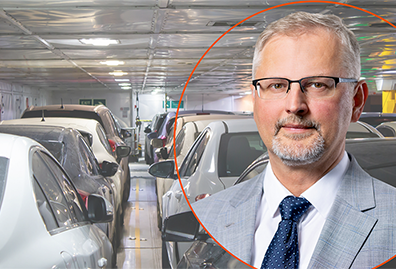Early detection is key to preventing shipboard electrical vehicle fires, advises Survitec
08/02/23

Following several high-profile ship fires involving electric vehicles (EVs), leading Survival Technology solutions provider Survitec is advising operators of vessels transporting hybrid and EVs – such as ferries, ropaxes, roros, PCCs and PCTCs – on how best to prevent and control fire onboard ship involving lithium-ion batteries.
As part of ongoing initiatives within the industry to improve safety, there is a drive to develop early fire detection systems to better monitor and protect car decks and lithium-ion batteries installed in vehicles onboard. Any slight deviation in properties can provide an early indication that conditions are right for a fire and afford time to take preventative measures to protect or quarantine hybrid and EVs.
Pre-ignition signs of a battery fire include heat and smoke from parts of the vehicle where the battery is usually placed, popping sounds from battery cells, and toxic gas emissions.
While early detection solutions are readily available, Rafal Kolodziejski, Survitec’s Head of Product Support & Development - Fire Systems, revealed that these systems are not yet adapted to allow for pre-fire conditions specific to lithium-ion batteries. That is, not only smoke and heat but also gas emissions, including, potentially, sound frequencies related to gas release.
“Monitoring car decks for early-stage fire conditions – typically any fluctuation in temperature or atmospheric condition – is critical to preventing fire propagation. The type and location of sensors are vitally important.
Kolodziejski said that Survitec is investing “heavily in the development of new solutions capable of pre-ignition monitoring” and is working with a major ship operator to design a comprehensive fire detection and extinguishing system for the EV cargo deck of a new build PCC (Pure Car Carrier).
Currently in development, the company’s integrated graphical monitoring system can provide real-time status of all the fire-protected zones onboard. The monitoring system will link all the detection systems and sensors onboard to allow for the remote or local activation of a compartment’s fire suppression system.
“An EV battery fire is different to any other type of fire in that the battery generates explosive and toxic gases, increasing the size and propagation of the fire,” explained Kolodziejski.
“The heat is, therefore, more intense, and an extinguished fire can potentially reignite at any time until the battery is completely burnt down. This presents a real challenge regarding gas-based fixed fire systems, such as CO2. Traditionally, a system pack has sufficient gas for just one discharge in the event of a fire. Currently, the Class societies propose that double the gas volume is provided, but this may not be enough to control fire or prevent reignition”, he continued.
Water-based solutions provide the best cooling effect, which is crucial in the case of this type of fire. However, the volume of water required to control an EV deck fire could impact ship stability, so a suitable drainage system must also be considered. Research shows that a water mist system has the highest efficiency for this type of fire. However, because battery modules are installed under the floor in most EVs, the most significant heat will be generated at deck level. There are various R&D initiatives investigating the best water spraying method for this. One of these solutions is a pop-up nozzle that sprays water mist upwards and fixed, and mobile solutions are now at the testing stage.
Fire onboard ships where EVs may be involved is now a genuine industry concern, and, referring to guidelines the European Maritime Safety Agency (EMSA) published in May last year, Kolodziejski highlights some of the recommendations currently being proposed to limit fire propagation and allow for effective monitoring of the environment around EV cargoes and also easy access in the event of a fire. For example, EV car-carrying ship owners are urged to consider increasing the space between each vehicle or reducing the number of units transported. Some ship operators are already requesting that batteries in used or secondhand EVs are disconnected prior to shipment, especially if EVs or their batteries show signs of damage.
“Prevention is certainly better than the cure at the moment,” said Kolodziejski. “Early monitoring and detection are becoming increasingly important safety factors for ship operators and crew. With an EV cargo, the earlier the crew can detect pre-fire conditions, the better.”
